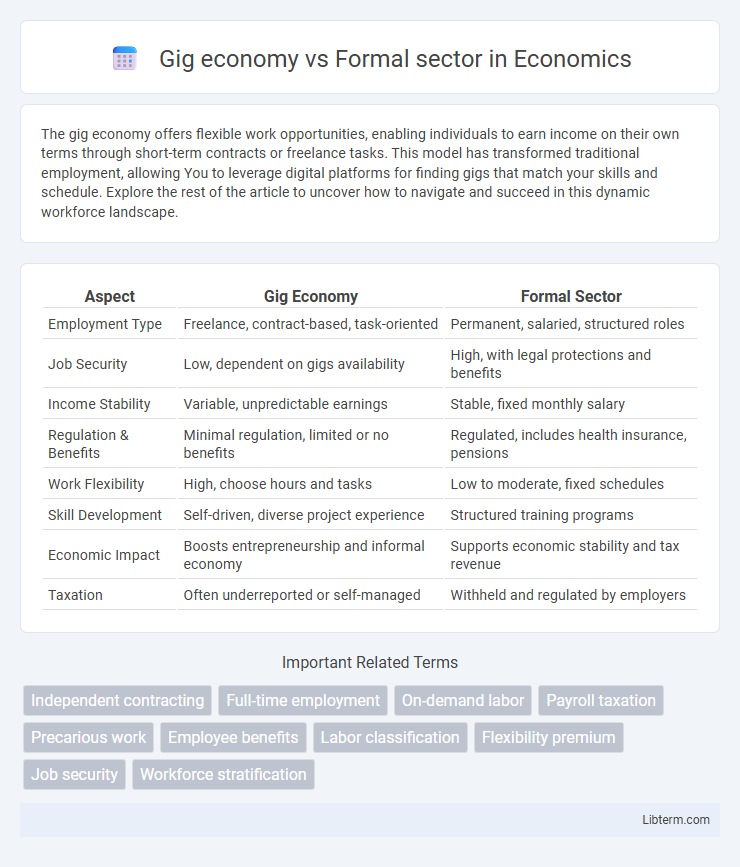The gig economy offers flexible work opportunities, enabling individuals to earn income on their own terms through short-term contracts or freelance tasks. This model has transformed traditional employment, allowing You to leverage digital platforms for finding gigs that match your skills and schedule. Explore the rest of the article to uncover how to navigate and succeed in this dynamic workforce landscape.
Table of Comparison
| Aspect | Gig Economy | Formal Sector |
|---|---|---|
| Employment Type | Freelance, contract-based, task-oriented | Permanent, salaried, structured roles |
| Job Security | Low, dependent on gigs availability | High, with legal protections and benefits |
| Income Stability | Variable, unpredictable earnings | Stable, fixed monthly salary |
| Regulation & Benefits | Minimal regulation, limited or no benefits | Regulated, includes health insurance, pensions |
| Work Flexibility | High, choose hours and tasks | Low to moderate, fixed schedules |
| Skill Development | Self-driven, diverse project experience | Structured training programs |
| Economic Impact | Boosts entrepreneurship and informal economy | Supports economic stability and tax revenue |
| Taxation | Often underreported or self-managed | Withheld and regulated by employers |
Understanding the Gig Economy and Formal Sector
The gig economy consists of short-term, flexible jobs often facilitated through digital platforms, allowing workers to engage in freelance or contract work without long-term commitments. In contrast, the formal sector involves structured employment with fixed schedules, legal protections, and benefits such as health insurance and retirement plans, typically governed by labor regulations. Understanding the distinctions between these sectors highlights differences in job security, income stability, and worker rights, essential for shaping labor policies and economic planning.
Key Differences Between Gig and Formal Employment
Gig economy employment is characterized by flexible, short-term contracts where workers are typically classified as independent contractors without access to traditional benefits such as health insurance or retirement plans. In contrast, formal sector jobs offer long-term employment with regulatory protections, fixed salaries, and employee benefits governed by labor laws. The gig economy emphasizes autonomy and task-based work, while the formal sector prioritizes job security, structured career progression, and compliance with labor standards.
Flexibility and Work-Life Balance Comparison
The gig economy offers unparalleled flexibility, allowing workers to choose hours and projects that fit their personal schedules, which can enhance work-life balance for those valuing autonomy. In contrast, the formal sector typically involves fixed schedules and structured environments, providing predictability but often limiting personal time management. This trade-off highlights the gig economy's adaptability versus the formal sector's stability in shaping work-life harmony.
Income Stability: Gig Economy vs Formal Sector
Income stability in the gig economy is often unpredictable, with workers facing fluctuating earnings due to variable demand and lack of guaranteed hours. The formal sector typically offers consistent salaries, benefits such as health insurance, and legal protections that ensure steady monthly income. Economic analyses highlight that formal employment contributes to financial security, whereas gig work income can vary widely, affecting long-term financial planning and stability.
Job Security and Employment Benefits
Job security in the gig economy is typically lower due to its contract-based and flexible nature, lacking guaranteed hours or long-term employment commitments found in the formal sector. Employment benefits such as health insurance, retirement plans, and paid leave are standard in the formal sector but often absent or inconsistent in gig work. Workers in the formal sector benefit from stronger labor protections and social safety nets compared to gig economy participants, who rely more on individual arrangements and platform policies.
Skills Development and Career Growth Opportunities
The gig economy offers flexible skill development through diverse short-term projects, enabling workers to rapidly acquire specialized expertise in areas like digital marketing, coding, and graphic design. In contrast, the formal sector provides structured career growth with access to comprehensive training programs, mentorship, and clear promotion pathways within established industries such as finance, healthcare, and manufacturing. While gig workers benefit from adaptability and variety, formal sector employees experience sustained professional development and long-term job security.
Legal Protections and Workers’ Rights
Workers in the gig economy often lack the comprehensive legal protections and workers' rights guaranteed in the formal sector, such as minimum wage, health benefits, and collective bargaining rights. Formal sector employees typically benefit from labor laws that ensure job security, workplace safety, and social insurance coverage, which are frequently absent for gig workers classified as independent contractors. This disparity fuels ongoing debates about regulatory reforms to extend legal safeguards and fair labor standards to gig economy participants.
Taxation and Financial Implications
The gig economy generates variable income streams often subject to self-employment taxes, complicating tax compliance for workers lacking standardized payroll systems found in the formal sector. Formal sector employees benefit from employer withholdings and contributions to social security and unemployment insurance, providing more predictable tax liabilities and financial protections. Tax authorities face challenges in capturing gig income accurately, impacting revenue collection and necessitating tailored financial regulations to address the gig economy's decentralized nature.
Impact on Society and Economic Growth
The gig economy, characterized by flexible, short-term contracts, enhances workforce adaptability and promotes entrepreneurial opportunities, driving innovation and consumer choice. In contrast, the formal sector provides stable employment with comprehensive benefits, fostering long-term economic security and social welfare. The coexistence of both sectors balances rapid economic growth with social stability, influencing income distribution and labor market dynamics.
Future Trends: Gig Economy or Formal Sector?
The gig economy is projected to expand rapidly, driven by technological advancements and increasing demand for flexible work arrangements, with platforms like Uber and Upwork leading growth. Conversely, the formal sector will continue to emphasize regulatory compliance, job security, and employee benefits, which remain crucial for workforce stability and economic resilience. Future labor markets are likely to witness hybrid models integrating gig flexibility with formal sector protections, shaping employment structures globally.
Gig economy Infographic

 libterm.com
libterm.com